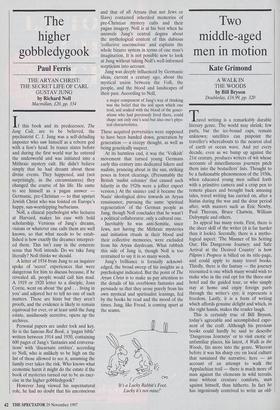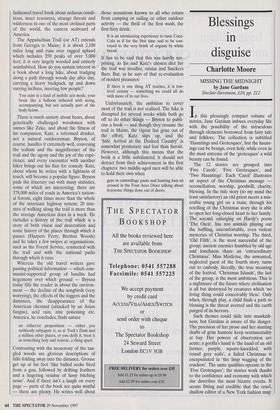Two middle-aged men in motion
Kate Grimond
A WALK IN THE WOODS by Bill Bryson Doubleday, £16.99, pp. 320 Tavel writing is a remarkably durable literary genre. The world may shrink; few parts, bar the ice-bound caps, remain unknown; satellites can pinpoint the traveller's whereabouts to the nearest clod of earth or ocean wave. And yet every decade, even as we bump up against the 21st century, produces writers of wit whose accounts of miscellaneous journeys pitch them into the bestsellers' lists. Thought to be a fashionable phenomenon of the 1930s, when educated young men sallied forth with a primitive camera and a crisp pen to remote places and brought back amusing tales, travel writing has carried on, after a hiatus during the war and the dour period after, with masters such as Eric Newby, Paul Theroux, Bruce Chatwin, William Dalrymple and others.
Its appeal has many roots. First, there is the sheer skill of the writer (it is far harder than it looks). Secondly, there is a mytho- logical aspect: 'The Manner of his Setting Out; His Dangerous Journey; and Safe Arrival at the Desired Country' is how Pilgrim's Progress is billed on its title-page, and could apply to many travel books. Thirdly, there is the fantasy — the journey recounted is one which many would wish to make who in the end opt for the three-star hotel and the guided tour, or who simply stay at home and enjoy foreign parts through the writer's eye; it represents a freedom. Lastly, it is a form of writing which affords genuine delight and which, in the right hands, makes the reader laugh.
This is certainly true of Bill Bryson, today's agreeable and accomplished expo- nent of the craft. Although his previous books could hardly be said to describe `Dangerous Journeys' or to visit exotic or unfamiliar places, his latest, A Walk in the Woods, fits more into the genre. Whereas before it was his sharp eye on local culture that sustained the narrative, here — an account of an attempt to walk the Appalachian trail — there is much more of man against the elements in wild terrain, man without creature comforts, man against himself, than hitherto. In fact he has ingeniously contrived to write an old- fashioned travel book about arduous condi- tions, inner resources, strange threats and wilderness in one of the most civilised parts of the world, the eastern seaboard of America.
The Appalachian Trail (or AT) extends from Georgia to Maine; it is about 2,100 miles long and runs over ragged upland which includes 350 peaks of over 5,000 feet; it is very largely wooded and entirely uninhabited. How do you sustain interest in a book about a long hike, about trudging along a path through woods day after day, carrying a heavy backpack, up and down varying inclines, meeting few people?
You exist in a kind of mobile zen mode, your brain like a balloon tethered with string, accompanying, but not actually part of the body below.
There is much anxiety about bears, about genetically challenged woodsmen with names like Zeke, and about the fitness of his companion, Katz, a reformed drinker, not a natural outdoorsman. Bryson, of course, handles it extremely well, conveying the tedium and the magnificence of the trail and the agony and the joy of the expe- rience, and every encounter with another hiker brings out his flair for comedy. Katz, about whom he writes with a lightness of touch, will become a popular figure. Bryson pads the itinerary out with many statistics, some of which are interesting; there are 378,000 miles of roads in America's nation- al forests, eight times more than the whole of the interstate highway system; 20 min- utes of walking along the trail is more than the average American does in a week. He includes a history of the trail which is a story of both vision and desecration and some history of the places through which it passes (Harpers Ferry, Bretton Woods) and he takes a few swipes at organisations, such as the Forest Service, connected with the trail and with the national parks through which it runs.
Whereas the old travel writers gave passing political information — which com- munist-supported group of bandits had hegemony over which ground — Bryson today fills the reader in about the environ- ment — the decline of the songbirds (very worrying), the effects of the loggers and the dammers, the disappearance of the American chestnut (attacked by an Asian fungus), acid rain, zinc poisoning etc. America, he concludes, finds nature an either/or proposition — either you ruthlessly subjugate it, as at Tock's Dam and a million other places, or you deify it, treat it as something holy and remote, a thing apart.
Contrasting with the monotony of the tan- gled woods are glorious descriptions of hills folding away into the distance. Grouse get up at his feet `like balled socks fired from a gun, followed by drifting feathers and a lingering residue of fussy bitching noise'. And if there isn't a laugh on every page — parts of the book are quite wistful — there are plenty. He writes well about those sensations known to all who return from camping or sailing or other outdoor activity — the thrill of the first wash, the first fizzy drink: It is an intoxicating experience to taste Coca- Cola as if for the first time and to be con- veyed to the very brink of orgasm by white bread.
It has to be said that this was hardly sur- prising, as his and Katz's chosen diet for the trail was noodles, raisins and Snickers Bars. But, as he says of that re-evaluation of modest pleasures: If there is one thing AT teaches, it is low- level ecstasy — something we could all do with more of in our lives.
Unfortunately, the ambition to cover most of the trail is not realised. The hike is disrupted for several weeks while both go off to do other things — Bryson to publi- cise a book — and though they resume the trail in Maine, the vigour has gone out of the effort, Katz slips up, and the `Safe Arrival at the Desired Country' is somewhat premature and less than heroic. However, although this means that the book is a little unbalanced, it should not detract from their achievement in the first chapters: two middle-aged men will be able to hold their own when guys in camouflage pants and hunting hats sit around in the Four Aces Diner talking about fearsome things done out of doors.



















































































 Previous page
Previous page